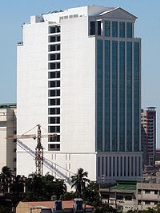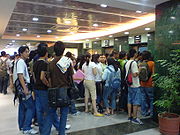
Br. Andrew Gonzalez Hall
Encyclopedia
The Br. Andrew Gonzalez Hall (Building code: A; also known as Gen Ed Building or "A" Building) is a 20 storey academic complex designed by Philip H. Recto Architects for De La Salle University
. It is located on a 1,700-square-meter lot between Taft Avenue and Fidel Reyes St. and in front of the Enrique M. Razon Sports Center
. Rising to a height of 90 meters, it is said to be the highest educational structure in the Philippines
. The building houses the General Education Department, the College of Education and the Asia-Pacific Center for Teachers’ Education and Development (ACTED). The building was formerly referred to as the GE/CED/ACTED Building before being named in honor of Br. Andrew Gonzalez FSC on September 28, 2005. The building was formally inaugurated on March 1, 2007 in celebration of Br. Andrew's 67th birthday. The building was opened for use in May 2006 for the first trimester despite not being completely finished at the time.
Eduardo G. Fajardo, chairman of the Natividad Galang-Fajardo Foundation, Inc., contributed a significant amount for the construction of the building. Fajardo was born to a poor family and worked hard to alleviate his family from poverty. He credits his success to education and contributed various material and buildings to different schools.


 The building has nine floors with classrooms of different sizes: lecture rooms with the capacity to hold 120 students, regular classrooms that can hold at most 45 students, and small classrooms for 25 students. The Undergraduate Admissions Office was transferred from the St. La Salle Hall
The building has nine floors with classrooms of different sizes: lecture rooms with the capacity to hold 120 students, regular classrooms that can hold at most 45 students, and small classrooms for 25 students. The Undergraduate Admissions Office was transferred from the St. La Salle Hall
in July 2006 and is now located on the ground floor of the Gonzalez Hall. The extension of the University Library can be found on the second floor, and parking for 120 cars on the third to sixth floors. A cafeteria is also located on the sixth floor, a chapel on the 14th floor, and a study hall on the 15th floor.
The College of Education occupies the 15th to 18th floors while the ACTED occupies the 19th to 20th floors. The system offices, where the university president holds office, occupy the topmost floor. There is also an auditorium on the 19th floor and a multi-purpose hall on the topmost floor.
It is also home to the Br. J. Benedict Learning Resource Center (LRC) and is for the exclusive use of the scholars of the Natividad Galang-Fajardo Foundation. The LRC was named after Br. J. Benedict FSC, who was last the Vice-President for Alumni Affairs of De La Salle University and was established through a grant from Foundation. The Center has a considerable collection of books and DVD
s about the fields of technology
, science
, economics
, psychology
, sociology
, and the arts
.
of the campus as well as to have a modern-looking structure in his design. As a result, the architectural style he adopted is a modern interpretation of neoclassical design. It retains the beautiful form and proportion of classical architecture but is executed in modern lines and using modern materials such as high-reflective glass curtain walls and high-tech equipment.
According to Recto, the predominantly vertical lines in the green and white facade signify the pursuit of lofty aspirations while bright colors in the interiors portray youthfulness, vibrancy and dynamism. The total design exudes an aura of simplicity, beauty and modernity.
De La Salle University
De La Salle University is a private Lasallian university in Malate, Manila, Philippines. It was founded in 1911 by De La Salle Brothers as the De La Salle College in Paco, Manila with Blimond Pierre serving as its first director...
. It is located on a 1,700-square-meter lot between Taft Avenue and Fidel Reyes St. and in front of the Enrique M. Razon Sports Center
Enrique M. Razon Sports Center
The Enrique M. Razon Sports Center of De La Salle University is a ten-storey neoclassical building that was built in 1998 to replace the old Brother Lucian Athanasius FSC Gym that was demolished in 2000 to give way for the construction of the Yuchengco Hall...
. Rising to a height of 90 meters, it is said to be the highest educational structure in the Philippines
Philippines
The Philippines , officially known as the Republic of the Philippines , is a country in Southeast Asia in the western Pacific Ocean. To its north across the Luzon Strait lies Taiwan. West across the South China Sea sits Vietnam...
. The building houses the General Education Department, the College of Education and the Asia-Pacific Center for Teachers’ Education and Development (ACTED). The building was formerly referred to as the GE/CED/ACTED Building before being named in honor of Br. Andrew Gonzalez FSC on September 28, 2005. The building was formally inaugurated on March 1, 2007 in celebration of Br. Andrew's 67th birthday. The building was opened for use in May 2006 for the first trimester despite not being completely finished at the time.
Eduardo G. Fajardo, chairman of the Natividad Galang-Fajardo Foundation, Inc., contributed a significant amount for the construction of the building. Fajardo was born to a poor family and worked hard to alleviate his family from poverty. He credits his success to education and contributed various material and buildings to different schools.
Building layout



St. La Salle Hall
The St La Salle Hall is an H-shaped four-storey structure built in the neoclassical style. It faces Taft Avenue in the district of Malate in Manila, Philippines...
in July 2006 and is now located on the ground floor of the Gonzalez Hall. The extension of the University Library can be found on the second floor, and parking for 120 cars on the third to sixth floors. A cafeteria is also located on the sixth floor, a chapel on the 14th floor, and a study hall on the 15th floor.
The College of Education occupies the 15th to 18th floors while the ACTED occupies the 19th to 20th floors. The system offices, where the university president holds office, occupy the topmost floor. There is also an auditorium on the 19th floor and a multi-purpose hall on the topmost floor.
It is also home to the Br. J. Benedict Learning Resource Center (LRC) and is for the exclusive use of the scholars of the Natividad Galang-Fajardo Foundation. The LRC was named after Br. J. Benedict FSC, who was last the Vice-President for Alumni Affairs of De La Salle University and was established through a grant from Foundation. The Center has a considerable collection of books and DVD
DVD
A DVD is an optical disc storage media format, invented and developed by Philips, Sony, Toshiba, and Panasonic in 1995. DVDs offer higher storage capacity than Compact Discs while having the same dimensions....
s about the fields of technology
Technology
Technology is the making, usage, and knowledge of tools, machines, techniques, crafts, systems or methods of organization in order to solve a problem or perform a specific function. It can also refer to the collection of such tools, machinery, and procedures. The word technology comes ;...
, science
Science
Science is a systematic enterprise that builds and organizes knowledge in the form of testable explanations and predictions about the universe...
, economics
Economics
Economics is the social science that analyzes the production, distribution, and consumption of goods and services. The term economics comes from the Ancient Greek from + , hence "rules of the house"...
, psychology
Psychology
Psychology is the study of the mind and behavior. Its immediate goal is to understand individuals and groups by both establishing general principles and researching specific cases. For many, the ultimate goal of psychology is to benefit society...
, sociology
Sociology
Sociology is the study of society. It is a social science—a term with which it is sometimes synonymous—which uses various methods of empirical investigation and critical analysis to develop a body of knowledge about human social activity...
, and the arts
The arts
The arts are a vast subdivision of culture, composed of many creative endeavors and disciplines. It is a broader term than "art", which as a description of a field usually means only the visual arts. The arts encompass visual arts, literary arts and the performing arts – music, theatre, dance and...
.
Design
Recto considered the school's desire to preserve the existing neoclassical architectureNeoclassical architecture
Neoclassical architecture was an architectural style produced by the neoclassical movement that began in the mid-18th century, manifested both in its details as a reaction against the Rococo style of naturalistic ornament, and in its architectural formulas as an outgrowth of some classicizing...
of the campus as well as to have a modern-looking structure in his design. As a result, the architectural style he adopted is a modern interpretation of neoclassical design. It retains the beautiful form and proportion of classical architecture but is executed in modern lines and using modern materials such as high-reflective glass curtain walls and high-tech equipment.
According to Recto, the predominantly vertical lines in the green and white facade signify the pursuit of lofty aspirations while bright colors in the interiors portray youthfulness, vibrancy and dynamism. The total design exudes an aura of simplicity, beauty and modernity.

